Of gemstones and fascination: “Dare to do it!”
Of gemstones and fascination: “Dare to do it!”
22.03.2022
In December 2021, the mineralogist Manuela Zeug has been awarded the Marie Jahoda scholarship of the University of Vienna. Mineralogy, she says, is a ”fascinating science, that significantly contributes to the economy and, in particular, to the development of new materials.” In planning her future, the new ”Kettenvertragsregelung” also plays a major role: “You always have to stay mobile in the hope that one day you will be able to settle somewhere,” says the passionate researcher and mother of two children.
Even as a child, Manuela Zeug collected "kilos" of stones during the vacations. Born and raised in Hamburg, Germany, she started her scientific career in geology: “I was interested in the whole story, the development of the Earth's history,” Manuela Zeug explains.
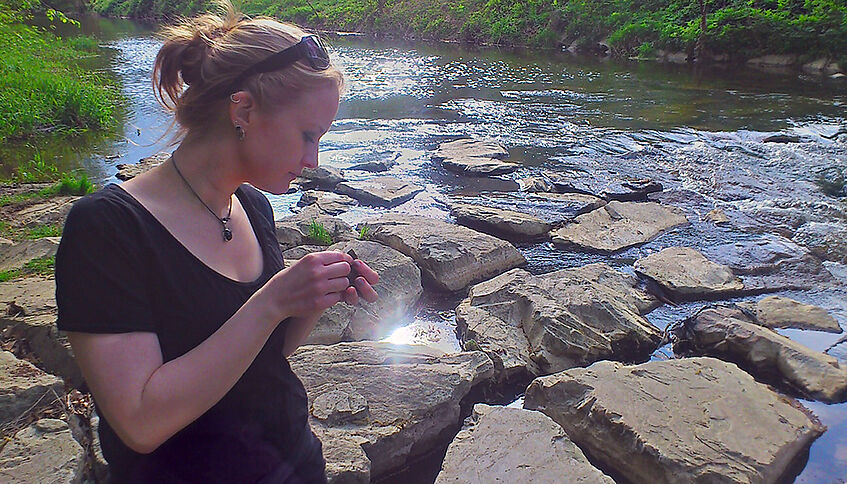
Manuela Zeug, from Hamburg, started her scientific career in geology, but soon she was drawn to mineralogy – and to Vienna. Photo: © Manuela Zeug/University of Vienna
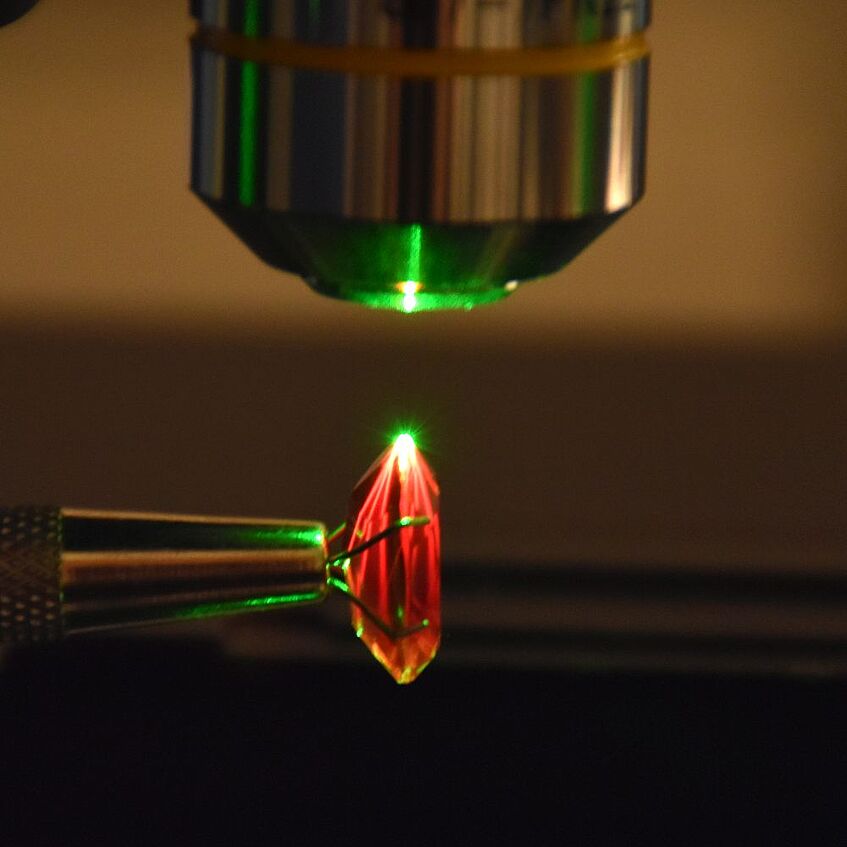
Edelstein unter Anregung mit einem grünen Laser (532nm) Foto: © Manuela Zeug/Universität Wien
Since the beginning of her studies she has been interested in mineralogy, and especially in gemstones. However, she was not only fascinated by the beauty of these stones, but rather by the conditions of their formation and the various applications: “No matter if we are talking about shatter-proof and scratch-resistant mobile phone displays, the sapphire used for scratch-proof watches or neodymium-doped yttrium aluminium garnet used as lasing medium for solid-state lasers: A lot of knowledge about these minerals and their synthetic equivalents is needed to develop new applications and to improve existing ones.,” says the mineralogist.
“Really happy”
In her diploma thesis, she investigated, among other things, titanium-rich garnets and thus combined geology and mineralogy. Then, she decided to focus on the spectroscopy of gemstones and came to Austria: “I was really happy when I was accepted for a PhD position at the University of Vienna, that was supervised by Lutz Nasdala, one of the leading international scientists in this field,” says Manuela Zeug.
For her doctoral thesis, she has specialised in the spectroscopy of gem materials since 2012, “particularly in the light-spectroscopic micromethods, such as Raman spectroscopy, which can be used to distinguish gemstones from their imitations”.
Raman spectroscopy
Raman spectroscopy reveals the material composition, crystallinity, crystallographic orientation or even strain or stress in a mineral. The basic principle: Incident light interact with the molecules of the investigated material. Each molecule absorbs the portion of light that is needed to vibrate. The scattered light, which is now of lower energy, is then collected by a detector and translated into a spectrum. This spectrum is characteristic for each mineral. Accordingly, Raman spectroscopy allows the non-destructive in-situ identification of gemstones in jewellery.
This method can even be used to reveal enhancement techniques of gemstones.: “For example, fracture filling in diamonds, rubies or emeralds with lead glass or certain (artificial) resins or oils to improve the clarity of the gemstones - but Raman spectroscopy can be used to identify such treatments comparatively quickly and non-destructively,” explains Manuela Zeug.
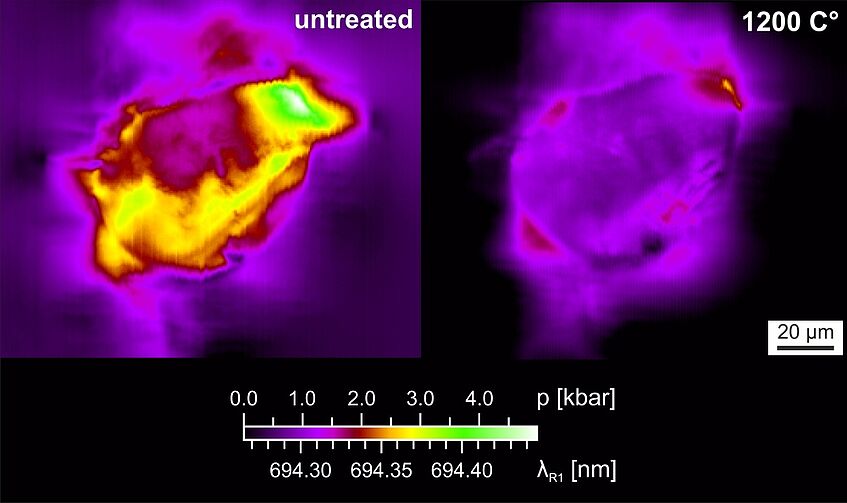
Color-coded hyperspectral maps showing the distribution of compressive stress in the host corundum around a radiation-damaged zircon before and after heat-treatment at 1200 C°, determined by the pressure-induced upshift of the Cr3+ emission (R1 band at ~694nm) of the host corundum. Illustration: © Manuela Zeug/University of Vienna
After finishing her PhD at the end of 2019, she is working as a temporary scientific assistant at the Department of Mineralogy and Crystallography; starting in December 2021, her research will now be supported by the Marie Jahoda Fellowship of the University of Vienna. What follows is still uncertain: “Due to the new university law and its new ‘Kettenvertragsregelung’, planning the future is somewhat difficult at the moment,” says Manuela Zeug.
"Have to be flexible"
She considers to submit another research project, but without a vacant position, she would probably go abroad with her husband, who is also a mineralogist and crystallographer. At the moment, however, everything is open: “We have to be flexibleand then we will see what the future may hold, but we also hope that we can settle somewhere soon,” says Manuela Zeug.
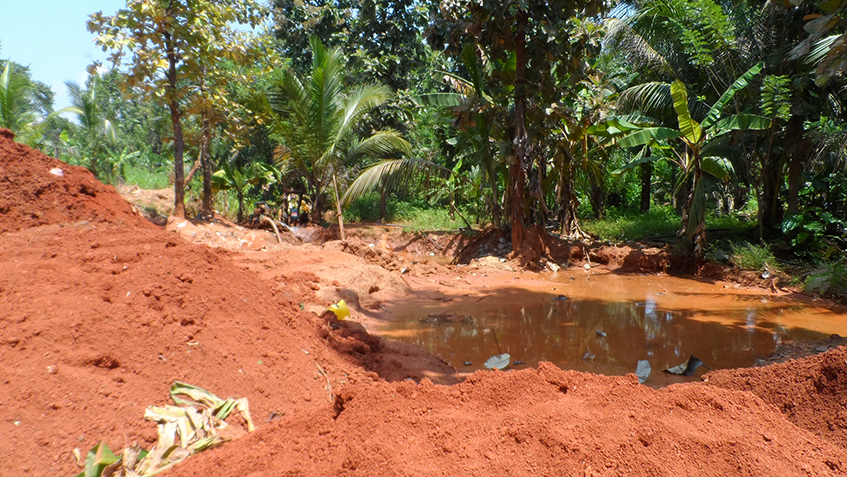
Manuela Zeug sees mineralogy and crystallography as an important link between geology, chemistry and physics, but also in terms of sustainability: “Research in environmental mineralogy, for example, is essential to find new ways to minimize environmental damage caused by mining activities.” The image shows a deposit in Sri Lanka. Photo: © Manuela Zeug/University of Vienna
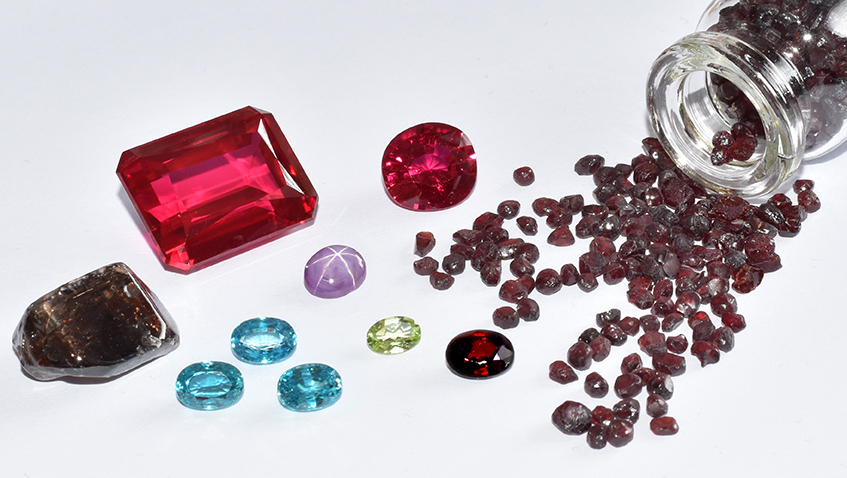
Knowing about the properties and the development of gemstones is also interesting for the industry – for example, in the case of shatter-proof and scratch-resistant mobile phone displays, the sapphire used for scratch-proof watches or yttrium aluminium garnet used as lasing medium for solid-state lasers. Photo: © Manuela Zeug/University of Vienna
In any case, her enthusiasm for this subject is still undiminished even today: “For me, mineralogy is a fascinating science, that is even relevant in the industry and, in particular, in the development of new materials.” It is therefore regrettable that the interest in this discipline has been steadily decreasing for years: “The number of students who sign up for this sub-discipline of the geosciences is constantly decreasing. I think that's a great pity."
A pity from a scientific point of view, because mineralogy and crystallography are important links between geology, chemistry and physics, but also in terms of sustainability: “Research in environmental mineralogy, for example, is essential to find new ways to minimize environmental damage caused by mining activities,” says Manuela Zeug. In addition, research can lead to the development of new synthetic materials for tools or products, constantly providing new areas of application in the industry.
”Thinking out of the box”
“In all these areas, the ability to think outside the box and an interdisciplinary mindset may be helpful,” the scientist explains. Since she has always been addressing many scientific questions, she maintains contact with colleagues from a wide range of disciplines – from gemmology and mineralogy to geology, economic geology and petrology: “This network is particularly important in practical issues and in writing research proposals,” she adds. As part of the Marie Jahoda scholarship, she is currently preparing a project proposal to be funded by third parties. The project aims at addressing light-spectroscopic micromethods and summarising and publishing her research findings in academic journals.
A broad network can be the deciding factor in looking for a permanent position. “I would like to continue with science, but the industry offers interesting possibilities too,” she adds. However, also in the industry the job opportunities for mineralogists are not especially golden either: “Although we combine many areas, the industry is looking for chemists or materials scientists. So, to everyone in the industry: Dare to hire mineralogists“, Manuela Zeug laughs.
